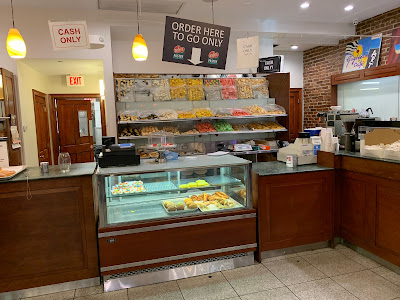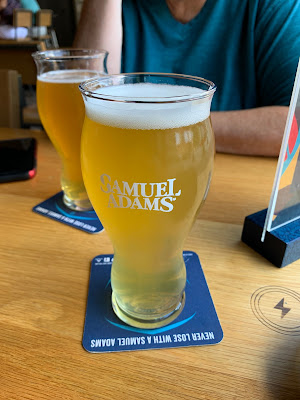After a relaxing night and a luxurious shower in the morning, we took a walk to get some breakfast. We knew about Mike's Pastry but we learned about Modern Pastry, another establishment on the next block. The statement about the two was that Mike's was for the tourists but the locals preferred Modern. So, we decided to be like the locals and headed to Modern.
We stood in line and there was a moment where we felt like we were in a Seinfeld episode - "No soup for you!"
It's definitely set up better for tourists - the afternoon before, the line was down the block when we went by.
Their specialty was cannolis and they advertised about 15 different flavors.
 |
| Yes, we took home a few |
Rather than carry around our goodies, we took them back to the hotel and rested for a bit. And then we were back at it.
A quick walk around Faneuil Hall, an historic marketplace and meeting hall, located near the site of the Boston Massacre in 1770. It was opened in 1742 and was the site of several speeches by Samuel Adams, James Otis, and others encouraging independence from Great Britain. It is sometimes referred to as "the Cradle of Liberty".
Quincy Market may be the most visited destination in Boston, an outdoor shopping area located next to Fanueil Hall. Quincy Market was converted from an old indoor open market to a shopping area many decades ago, completely revitalizing this area.
Boston has fascinating burial grounds with many patriots and founders that are, amazingly, still in the middle of the city and surrounded by large, contemporary buildings.
 |
| Mary Chilton and John Winslow |
The Granary Burial Ground contains approximately 2,345 gravestones and tombs, although it is estimated that 5,000 people are buried at this site. The gravestones' original haphazard configuration was rearranged into straighter rows over the years in order to accommodate both nineteenth century aesthetics and the modern lawnmower.
He's a true entrepreneur and has put together a notebook for visitors to use while they walk through the grounds. He makes the book free to borrow - he just asks that it is returned to him on the way out. And then "donations are accepted (but not expected)". He even has a website.
A few notables.
Samuel Adams was an American statesman, political philosopher, and a Founding Father He was a politician in colonial Massachusetts, a leader of the movement that became the American Revolution, and one of the architects of the principles of American republicanism that shaped the political culture of the United States. He was a second cousin to his fellow Founding Father, President John Adams.
Samuel Adams, 1722-1803
Signer of the Declaration of Independence
John Hancock was an American Founding Father and prominent Patriot of the American Revolution. He served as president of the Second Continental Congress and was the first and third Governor of the Commonwealth of Massachusetts. He is remembered for his large and stylish signature on the Declaration of Independence, so much that the term John Hancock or Hancock has become a synonym for one's signature. He also signed the Articles of Confederation and used his influence to ensure that Massachusetts ratified the US Constitution in 1788.
John Hancock, 1737-1793
And a third signer of the Declaration of Independence, Robert Treat Paine. Robert Paine was an American lawyer, politician and Founding Father who signed the Continental Association and the Declaration of Independence as a representative of Massachusetts. He served as the state's first attorney general and as an associate justice of the Massachusetts Supreme Judicial Court.
Robert Treat Paine, 1731-1841
There is a 'Franklin' obelisk which was erected in 1827 as a memorial to the parents and relatives of Benjamin Franklin who was born in Boston and is buried in Philadelphia. Josiah Franklin, Benjamin's father, was originally from Ecton, Northamptonshire, England and his mother, Abiah, was born in Nantucket and was Josiah's second wife. Constructed of granite from the Bunker Hill Monument quarry, the obelisk was constructed to replace the original Franklin family gravestones which had been in poor condition.
Paul Revere was an American silversmith, engraver, early industrialist, Sons of Liberty member and Patriot and Founding Father. He is best known for his midnight ride to alert the colonial militia in 1775 to the approach of British forces before the battles of Lexington and Concord. He later served as a Massachusetts militia officer, though his service ended after the Penobscot Expedition, one of the most disastrous campaigns of the American Revolutionary War, for which he was absolved of blame.
During the latter part of the war Revere served as an officer and engraved the first Continental money and the
official Massachusetts seal.
Following the war, Revere returned to his silversmith trade. He used the profits from his expanding business to finance his work in iron casting, bronze bell and cannon casting, and the forging of copper bolts and spikes. In 1800, he became the first American to successfully roll copper into sheets for use as sheathing on naval vessels.
The original gravestone for Paul Revere is small and unassuming.
At some point after the original gravestone was placed, a new monument was placed next to it.
Paul Revere, 1734-1818
And then on to Boston Common.
We walked through the park - lots of interesting things going on.
Not sure what instrument this guy was playing but he was entertaining
At the edge of the park is the State House (capitol).
We kept walking down Beacon Street as there was one more thing we wanted to see - Cheers!
This was particularly of interest to us because we've been watching the entire series if/when we can't get a Dish signal. We're on season 5. :-)
The Cheers Pub was founded in 1969 as the Bull & Finch Pub and was discovered in 1981 by Hollywood couple Mary Ann and Glenn Charles. During their visit, they photographed the interior and exterior of the pub which they then gave to the set designer back in Hollywood to replicate for the set of the TV show. In 1982, the year that the Cheers show premiered on television, Boston Magazine chose the Bull & Finch Pub as the "Best Neighborhood Bar" in Boston. The pub eventually changed its name to Cheers to avoid confusion.
We walked down "the" stairs....
....and went inside. SHOCK! It doesn't look the same! But at least everyone knows your name.
The wait for lunch was about 45 minutes so we moved on because we had more to explore.
We walked back to Faneuil Hall - boy it was hot! But there, like an oasis, was the Samuel Adams Taproom. Time for a break!
Ahhh, just what we needed!
We sat at a table by the open window and even though it was hot, the beer cooled us off. We had a nice view of the Samuel Adams statue and Faneuil Hall.
After our break, we walked towards the Old State House. It's amazing to have all of these historical buildings right in the center of town.
The Old State House was built in 1713 and was the seat of the Massachusetts General Court until 1798. It is the oldest surviving public building in Boston and one of the oldest public buildings in the United States. It now serves as a history museum.
There was a tour going on behind the State House so we stopped to listen for a few minutes.
We finally made our way back to the North End to get a late lunch. We'd seen a line (lots of lines around here) at a pizza place so we decided we'd give it a try.
They claim to be the best pizza in town and have been in business since 1926. Kind of a funky little place.
The 'leader' of the band was having a great time and the entire restaurant was clapping right along with him.
After a couple of songs, they found their way outside and marched through the streets. The band seemed to be part of the Italian festival "Procession of Saints" where money is pinned to ribbons on a statue of St. Mary Magdalen.
















































So funny that almost exactly two months later we took this same path along the Freedom Trail only in the opposite direction, starting from the Public Garden up to the Common. We tried to get into both Mike's and Modern, but the lines were ridiculous!
ReplyDeleteHaha. I was probably 2-3 weeks behind posting this blog so our paths might have passed. Mike's was crazy busy when we went by the day before so we were happy to be able to get inside the next morning.
Delete